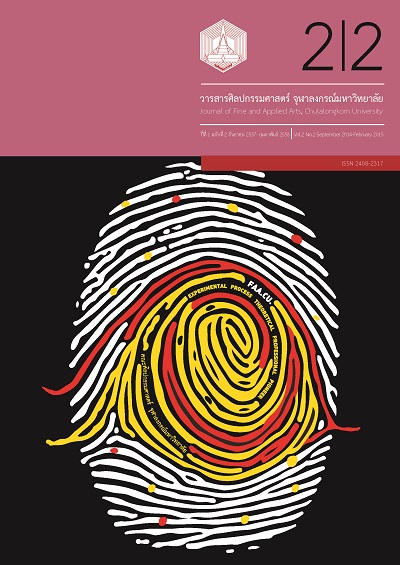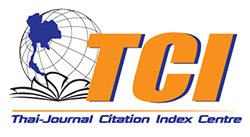นาฏยศิลป์ไทยร่วมสมัยในการแสดงแสงเสียงประกอบจินตภาพ เรื่อง เวียงกุมกาม: เมื่อสายน้าเอาชนะกษัตริย์ผู้ไม่แพ้ใคร
Keywords:
การแสดงแสงเสียงประกอบจินตภาพ, นาฏยศิลป์ไทยร่วมสมัย, เวียงกุมกาม, Light and sound performance, contemporary Thai dance, Wiang Kum KamAbstract
บทคัดย่อวิทยานิพนธ์ฉบับนี้มีวัตถุประสงค์มุ่งศึกษาและวิเคราะห์รูปแบบและบริบทการแสดงแสงเสียงประกอบจินตภาพ เรื่อง เวียงกุมกาม: เมื่อสายน้ำเอาชนะผู้ไม่แพ้ใครของศาสตราจารย์ ดร.นราพงษ์ จรัสศรี ด้วยวิธีการรวบรวมข้อมูลจากเอกสารทางวิชาการ การสังเกตการณ์ และการสัมภาษณ์
ผลการศึกษาพบว่า รูปแบบการแสดงเป็นการผสมผสานศาสตร์ทางด้านนาฏกรรมและการละครเข้าด้วยกันอย่างลงตัว โดยอาศัยเทคโนโลยีสมัยใหม่ประกอบการพรรณนาเล่าเรื่องราวทางประวัติศาสตร์เวียงกุมกาม โดยออกแบบสร้างสรรค์ลีลาทางนาฏยศิลป์ที่ผสมผสานศิลปวัฒนธรรมไทย นาฏยศิลป์ตะวันตกและนาฏยศิลป์ตะวันออก มาจัดแสดงร่วมกับปูชยนียสถาน รูปแบบดังกล่าวได้นำเสนอผ่านองค์ประกอบการแสดง อันได้แก่ บทการแสดง ลีลานาฏยศิลป์ นักแสดง เครื่องแต่งกาย ดนตรี ฉากเวที อุปกรณ์ประกอบการแสดง แสงเสียง เทคนิคพิเศษ และการแต่งหน้าทำผม เพื่อให้ผู้ชมเกิดความเข้าใจและสะท้อนบริบทที่สำคัญคือ ด้านประวัติศาสตร์ท้องถิ่น การนับถือศาสนาพุทธ ความเชื่อในเรื่อง ภูตผีปีศาจ และระบบกษัตริย์ การศึกษาในแง่แหล่งเรียนรู้หลาย ๆ ด้าน สะท้อนลักษณะพื้นที่ราบลุ่มต่ำติดแม่น้ำที่เป็นสาเหตุของปัญหาน้ำท่วมตั้งแต่อดีตจนถึงปัจจุบัน พัฒนาให้เป็นแหล่งท่องเที่ยวเพื่อเพิ่มรายได้ให้กับประชาชน ตลอดจนเป็นศูนย์รวมของศิลปะดนตรี นาฏยศิลป์ วรรณกรรม สถาปัตยกรรม และจิตรกรรมที่ทรงคุณค่าแก่การธำรงรักษาให้อนุชนรุ่นหลังได้ชม
Abstract
This thesis studies and analyzes the format and performing context of the light and sound performance, Wiang Kum kam: When Conquered the Undefeated King by Professor Naraphong Charassri, Ph.D. by collecting information from academic documents, observation and interview.
The research found that the performing format is a harmonious combination of performing arts and drama, employing modern technology to accompany the description of the historical accounts of Wiang Kum Kam. The dance style is a combination of Thai arts and culture, Western performing arts and Eastern performing arts, presented with stage scenery depicting the places of worship. This format is presented through performing components, consisting of the performance script, the dance style, the performers, the costumes, the music, the stage scenery, props, light, sound and special techniques, make-up and hairstyles that enhance the audience’s understanding and reflect the important contexts of local history, faith in Buddhism, beliefs in ghosts and spirits and the monarchy. The study of different education resources demonstrates the characteristics of the alluvial low plain near the river, which has caused floods from the past to the present and has now been developed to become a tourist site in order to provide additional income for the people as well as to serve as a centre of arts, music, dance, literature, architecture and paintings, all of which are worth preserving for future generations.
Downloads
Additional Files
Published
Issue
Section
License
ลิขสิทธิ์ของบทความเป็นของเจ้าของบทความ บทความที่ได้รับการตีพิมพ์ถือเป็นทัศนะของผู้เขียน
กองบรรณาธิการไม่จำเป็นต้องเห็นด้วยและไม่รับผิดชอบต่อบทความนั้น






